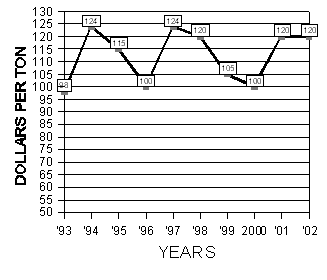Alfalfa Report
Yuma County, Arizona
March 25, 2002
Yuma County Office
2200 W. 28th Street, Ste. 102
Yuma, AZ 85364
(928) 726-3904
(928) 726-8472 FAX
Production Update:
Phosphorus fertilizer: In a 3-year study conducted at Maricopa (PDF file, 26KB), surface-applied 11-52-0 and water-run 10-34-0 were equally effective in increasing alfalfa yield. The fertilizer was applied annually in December. These results demonstrate that the alfalfa plant is capable of utilizing P from surface-applied fertilizer that is not mechanically incorporated. Most of the P fertilizer remained in the surface 3 inches of soil whether or not it was surface-applied or water-run.
Insect Management: [note - all picture links below will take you
to other sites,
hit your "back" button to return to this page] The blue
alfalfa, pea aphid (PDF file, 85 KB) (picture,
blue aphid) (picture,
pea aphid) and cowpea
aphid (picture)
populations are being kept in check by predators and parasites in alfalfa
fields this spring. Lady beetles observed feeding on aphids include seven
spotted lady beetle, Coccinella septempunctata, (picture)
the convergent lady beetle, Hippodamia convergens (adult
picture) (larvae
picture),and the ash gray lady beetle, Olla v-nigrum (picture).
Green lacewing larvae (picture)
have also been feeding on aphid species in alfalfa. Parasitic wasps attaching
aphids in alfalfa include Lysiphlebus sp. (picture)
and Diaraetiella sp. Beneficial insects play an important role
in alfalfa insect management and should be protected. Only treat pest
species with an insecticide when they reach the treatment threshold and
use insecticides that are least harmful to beneficial insects.
Weed Control: An alfalfa weed control field day is scheduled for Yuma and Erhenberg on Wednesday, April 3. It will be on Avenue 6 1/4 E and 32nd Street from 9:00 - 11:00 a.m. and in Ehrenberg from 2:00 - 4:00 p.m. across from the Rovey Equipment yard on Tsosie Road. Call the Extension office for details.
| Market Summary |
High
|
Low
|
Average
|
Off grade
|
| Past 2 Weeks ( Mar 12 - Mar 25, 2002) |
125
|
105
|
120
|
90-105
|
| Last Year (Mar 12 - Mar 25, 2001) |
125
|
115
|
120
|
90-110
|
10 Year Summary (March 12 - March 25, 1993-2002):

Issued in furtherance of Cooperative Extension work, acts of May 8 and June 30, 1914, in cooperation with the U.S. Department of Agriculture, James A. Christenson, Director Cooperative Extension, College of Agriculture and Life Sciences, The University of Arizona.
The University of Arizona is an equal opportunity, affirmative action institution. The University does not discriminate on the basis of race, color, religion, sex, national origin, age, disability, veteran status, or sexual orientation in its programs and activities.
Any products, services, or organizations that are
mentioned, shown, or indirectly implied in this web document do not imply
endorsement by The University of Arizona.
Information provided by:
Barry Tickes, btickes@ag.arizona.edu Extension Agent, Yuma County
Michael Ottman, mottman@ag.arizona.edu Agronomy Specialist
College of Agriculture, The University of Arizona.
Eric Natwick, etnatwick@ucdavis.edu UCCE Imperial County - Farm Advisor
University of California, Davis, CA.
Forages: Crop Mgmt | Soil Mgmt | Irrigation | Alfalfa Reports | Insects | Diseases | Weeds | Pesticides
Home | Other Crops | Forages
For more Arizona Production Ag Information:
Home | Cotton | Veggies| Forages | Grains | Citrus | Crop x Crop | Insects | Diseases| Weeds | Pesticides | News | Weather | Research | Photos | Contacts | General Info. | Site Map
Copyright © 2001 University of Arizona,
College of Agriculture and Life Sciences
Webmaster: Al Fournier (fournier@ag.arizona.edu)